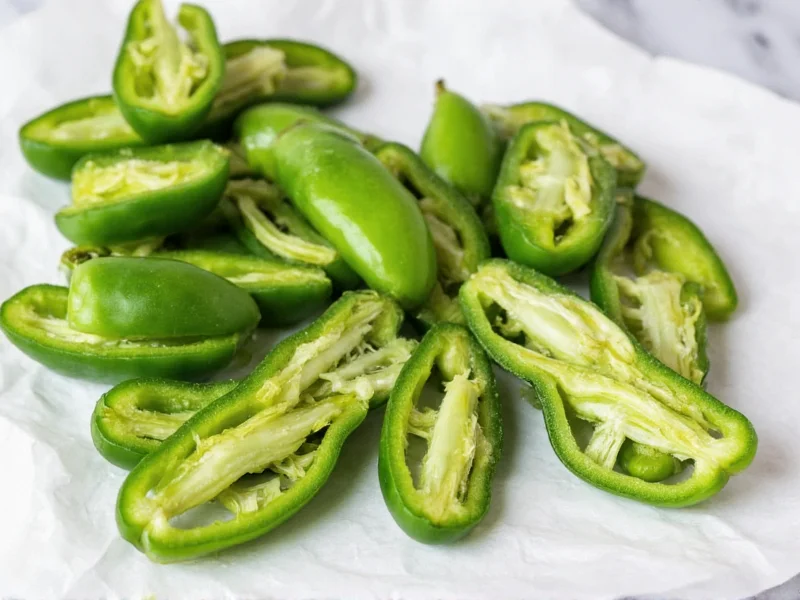Dehydrating jalapeños transforms these fiery peppers into versatile flavor powerhouses that last months while concentrating their distinctive heat and smoky notes. Whether you've harvested an abundant crop or found a great deal at the market, proper dehydration preserves jalapeños for use in rubs, powders, soups, and sauces year-round. This comprehensive guide details the three most reliable dehydration methods with precise timing and temperature guidance to achieve perfect results every time.
Why Dehydrate Jalapeños?
Dehydrated jalapeños offer significant advantages over fresh peppers. They occupy minimal storage space while maintaining 90% of their capsaicin content—the compound responsible for heat. The dehydration process concentrates flavors, making dried jalapeños ideal for creating homemade chili powder, infused oils, or spice blends. Unlike canned or pickled jalapeños, dehydrated versions contain no preservatives and can be rehydrated in minutes when needed for recipes requiring fresh pepper texture.
Safety First: Handling Hot Peppers
Always wear nitrile gloves when preparing jalapeños to prevent capsaicin burns on sensitive skin. Avoid touching your face, especially eyes, during processing. Work in a well-ventilated area as slicing releases volatile compounds that can irritate respiratory passages. After handling, clean all surfaces and tools with soapy water—alcohol solutions work particularly well for removing residual oils from cutting boards and knives.
Preparation Essentials
Select firm, blemish-free jalapeños with smooth skin for optimal dehydration results. Wash thoroughly under cold running water, then pat completely dry with clean towels. For consistent drying:
- Slice peppers into uniform 1/4-inch rings using a sharp chef's knife
- Remove seeds and membranes if milder heat is preferred
- Leave stems intact for hanging drying methods
- Arrange slices in single layer with space between pieces
| Preparation Method | Best For | Processing Time |
|---|---|---|
| Thin rings (1/4") | Dehydrator/oven methods | 8-12 hours |
| Halves (seeded) | Intense flavor concentration | 10-14 hours |
| Whole (stems attached) | Stringing/rainbow drying | 2-3 weeks |
Three Proven Dehydration Methods
Food Dehydrator Method (Recommended)
This electric appliance provides the most consistent results for how to dehydrate jalapenos properly. Arrange prepared slices in single layers on trays without overlapping. Set temperature to 135°F (57°C)—higher temperatures can cook rather than dry peppers, diminishing flavor. Rotate trays every 4 hours for even drying. Check for doneness after 8 hours; properly dehydrated jalapeños should be brittle with no moisture when snapped.
Oven Dehydration Technique
When a dehydrator isn't available, your oven works for dehydrating jalapenos without special equipment. Preheat to lowest possible setting (typically 140-170°F). Place pepper slices on wire racks over baking sheets to allow air circulation. Prop oven door open 2-3 inches using a wooden spoon to maintain proper airflow. Check every 30 minutes after first hour to prevent cooking. Total drying time ranges 6-10 hours depending on oven accuracy.
Air Drying Method
For those seeking how to dehydrate jalapenos naturally, air drying works in low-humidity environments. Thread whole peppers through stems onto cotton string, leaving 1-inch spacing. Hang in dark, well-ventilated area with temperatures between 70-80°F and humidity below 60%. Complete drying takes 2-3 weeks. Check weekly for mold development, especially in humid climates where this method proves unreliable.
Determining Complete Dehydration
Properly dehydrated jalapeños exhibit specific characteristics regardless of method used. They should feel completely brittle with no flexible sections. When broken, they snap cleanly rather than bending. Store a test piece in an airtight container for 24 hours; if condensation appears, return peppers to dehydrator for additional processing. Under-dried jalapeños risk mold growth during storage, while over-dried peppers become difficult to rehydrate effectively.
Optimal Storage Solutions
Store completely cooled jalapeños in airtight glass jars or vacuum-sealed bags with oxygen absorbers. Include silica gel packets to absorb residual moisture. Keep containers in a cool, dark pantry away from heat sources. Properly stored dehydrated jalapeños maintain peak quality for 12-18 months. For extended shelf life up to 5 years, freeze in moisture-proof containers. Always label containers with processing date to track freshness.
Creative Uses for Dehydrated Jalapeños
Reconstitute slices in warm water for 20 minutes when fresh texture is needed. Grind completely dry peppers into powder using a dedicated spice grinder for homemade chili seasoning. Infuse dried jalapeños in olive oil over low heat for flavored cooking oil. Add whole dried peppers to soups and stews during cooking, removing before serving. Create vibrant decorative ristras by stringing colorful dried peppers in alternating patterns.
Troubleshooting Common Issues
Peppers developing mold: Indicates insufficient drying or moisture exposure during storage. Discard affected batches immediately.
Uneven drying: Results from inconsistent slice thickness or poor air circulation. Always use mandoline for uniform slicing.
Bitter flavor: Caused by excessive heat during dehydration. Reduce temperature and increase drying time for future batches.
Loss of vibrant color: Exposure to light during storage degrades pigments. Use amber glass jars or opaque containers for maximum color retention.











 浙公网安备
33010002000092号
浙公网安备
33010002000092号 浙B2-20120091-4
浙B2-20120091-4